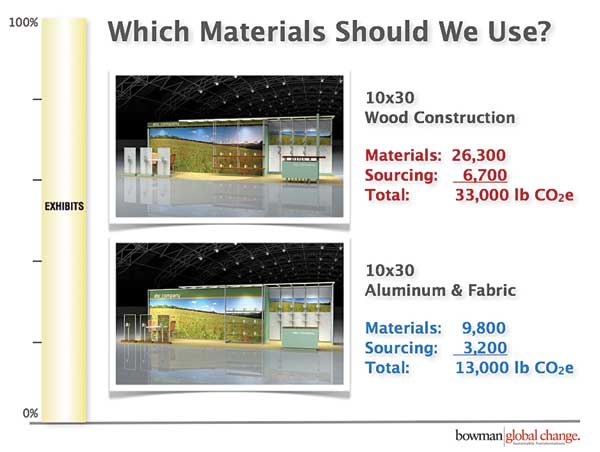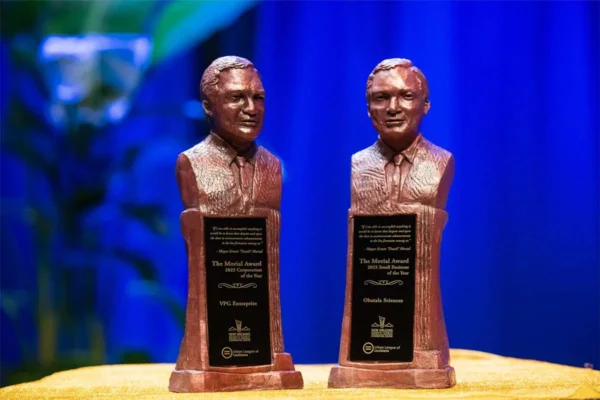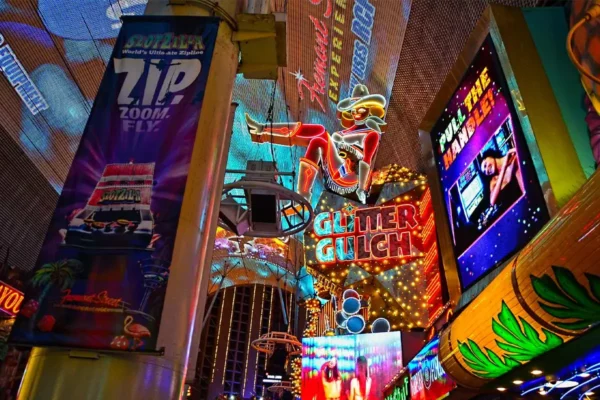Until now, going green in this, or any industry, has had certain flaws. Many companies may have wanted to go green but decided it was either too time consuming or too expensive. Plus, the return on investment was hard to calculate and the impact was difficult to see.
Tom Bowman, founder of Bowman Global Change, saw these challenges and decided to do something about them.
“Just trying to motivate people to be greener doesn’t help if they don’t know how to do it,” said Bowman. “The big myth in this industry is that going green has to be more expensive. Some green materials are more expensive, but that isn’t the only way for a company to go green.”
Bowman is also the president of Bowman Design Group and has been in the exhibit industry for more than 25 years.
In 2003, Bowman received a contract to design a museum for the National Academy of Scientists in Washington, DC.
“All of a sudden, I was working with some of the most imminent scientists in the world in areas such as public health, global warming and energy science,” said Bowman. “For anybody who really learns this stuff, it is a major eye-opening experience.”
This contract led to the launch of Bowman Global Change, which is a consultancy to engage clients in sustainability practices.
Bowman immediately recognized the questions created by going green and set out to answer them.
“How do you know what you are doing to go green is actually green? How can you be sure that you saved money and how can you be sure you are doing the right thing and not just guessing?” asked Bowman. “For example, everyone thinks that buying food locally for a reception or dinner is a green practice. But only 11 percent of the carbon footprint for food comes from the shipping. How the food is grown is 83 percent of the footprint.”
Bowman explained that if a meeting planner cuts back on meat and dairy, the food could come from across the globe and it would still cut down on the carbon footprint much more than if it came from one mile away.
According to Bowman, these are the types of problems and scenarios that keep companies from truly going green. It is because of these misconceptions that he created FootprintsTM, a computer program that measures the carbon footprint a company produces with its exhibit program. It identifies the best green options and shows a company how much money they can save by implementing changes.
“For the first time ever, we are able to map out the carbon footprint and generate real numbers” said Bowman. “Now, someone who has the task of going green can say to senior management, ‘I know how to do it and here are the cost savings.’”
FootprintsTM can run scenarios for the exhibit design program for any type of company. It is used to see how the carbon footprint is distributed between areas like construction, shipping, travel and hospitality, and where the best opportunities are for cost savings.
“If you are sending a lot of people to conferences and using pop-ups, then a green booth really isn’t going to help,” said Bowman. “If you build custom exhibits and ship them around the nation, then green materials are going to make a major impact.”
FootprintsTM wasn’t designed to add hassle to the day for the companies that use it. After the exhibiting company provides the initial information about its program, Bowman uses FootprintsTM to generate a report that shows the company how to make green decisions that also save money.
For example, if a company uses crates to ship its exhibit, what would the numbers show if it was skidded instead? In this scenario, FootprintsTM calculates a 25 percent reduction in the carbon footprint. It also showed a significant cost savings for shipping because a truck can hold many more properties if they are skidded.
It is situations just like this one that FootprintsTM was designed to tackle. It doesn’t turn going green into something new that a company has to do.
“You can save money by making the same decisions you were going to make anyway, you just have to make them with green in mind,” said Bowman. “Now, you will be able to stand up in front of your stake holders and show them proof that the company has gone green.”
Another example Bowman uses comes from the travel associated with attending tradeshows. Bowman ran a scenario that had nine people flying coach and three people flying first-class. He then changed the scenario so four representatives were hired locally and two first-class passengers flew coach.
The cost saving was over $30,000 depending on how many shows were attended, not to mention the reduction of the carbon footprint.
“If you were really deep into using our service, it may cost you $5,000 to $10,000,” said Bowman. “But if you can save $30,000 on one show and multiple that by six shows, it is a pretty good deal.”
Currently, Bowman is undergoing beta testing with clients to prove that the program works.
Interested exhibitors are invited to sign up for FootprintsTM at www.bowmanglobalchange.com.
| Home |
| People on the Move |
| National News |
| International News |
| Opinions |
| Tradeshow Calendar |






























